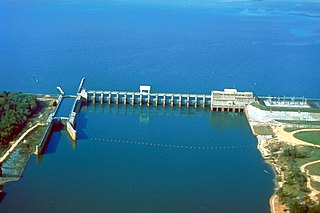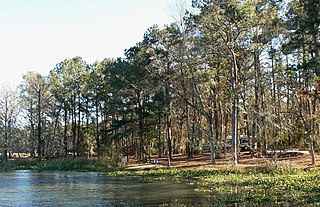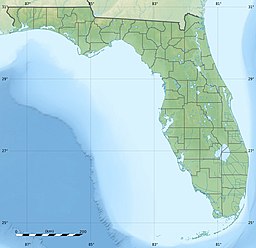
The Chattahoochee River is a river in the Southeastern United States. It forms the southern half of the Alabama and Georgia border, as well as a portion of the Florida and Georgia border. It is a tributary of the Apalachicola River, a relatively short river formed by the confluence of the Chattahoochee and Flint rivers and emptying from Florida into Apalachicola Bay in the Gulf of Mexico. The Chattahoochee River is about 430 miles (690 km) long. The Chattahoochee, Flint, and Apalachicola rivers together make up the Apalachicola–Chattahoochee–Flint River Basin. The Chattahoochee makes up the largest part of the ACF's drainage basin.

The Apalachicola-Chattahoochee-Flint River Basin is the drainage basin, or watershed, of the Apalachicola River, Chattahoochee River, and Flint River, in the Southeastern United States.

The Apalachicola River is a river, approximately 160 miles (260 km) long, in the state of Florida. The river's large watershed, known as the Apalachicola, Chattahoochee and Flint (ACF) River Basin, drains an area of approximately 19,500 square miles (50,500 km2) into the Gulf of Mexico. The distance to its farthest head waters in northeast Georgia is approximately 500 miles (800 km). Its name comes from Apalachicola Province, an association of Native American towns located on what is now the Chattahoochee River. The Spanish included what is now called the Chattahoochee River as part of one river, calling all of it from its origins in the southern Appalachian foothills down to the Gulf of Mexico the Apalachicola.

The Flint River is a 344-mile-long (554 km) river in the U.S. state of Georgia. The river drains 8,460 square miles (21,900 km2) of western Georgia, flowing south from the upper Piedmont region south of Atlanta to the wetlands of the Gulf Coastal Plain in the southwestern corner of the state. Along with the Apalachicola and the Chattahoochee rivers, it forms part of the ACF basin. In its upper course through the red hills of the Piedmont, it is considered especially scenic, flowing unimpeded for over 200 miles (320 km). Historically, it was also called the Thronateeska River.

Prospect Bluff Historic Sites is located in Franklin County, Florida, on the Apalachicola River, 6 miles (9.7 km) SW of Sumatra, Florida. The site contains the ruins of two forts.

Three Rivers State Park is a Florida State Park located north of Sneads, on the shores of Lake Seminole near the Georgia border, in northwestern Florida. It is named for the main rivers associated with Lake Seminole: the Chattahoochee and the Flint, and the Apalachicola The address is 7908 Three Rivers Park Road.

The Wiregrass region, also known as the Wiregrass plains or Wiregrass country, is an area of the Southern United States encompassing parts of southern Georgia, southeastern Alabama, and the Florida Panhandle. The region is named for the native Aristida stricta, commonly known as wiregrass due to its texture.

Lake Lanier is a reservoir in the northern portion of the U.S. state of Georgia. It was created by the completion of Buford Dam on the Chattahoochee River in 1956, and is also fed by the waters of the Chestatee River. The lake encompasses 38,000 acres (15,000 ha) or 59 sq mi (150 km2) of water, and 692 mi (1,114 km) of shoreline at normal level, a "full pool" of 1,071 ft (326 m) above mean sea level and the exact shoreline varies by resolution according to the coastline paradox. Named for Confederate poet Sidney Lanier, it was built and is operated by the U.S. Army Corps of Engineers for flood control and water supplies. Its construction destroyed more than 50,000 acres (20,000 ha) of farmland and displaced more than 250 families, 15 businesses, and relocated 20 cemeteries along with their remains in the process.

The Walter F. George Lake, named for Walter F. George (1878–1957), a United States senator from Georgia, is formed on the Chattahoochee River along the state line between Alabama and Georgia. It is also widely known by the name, Lake Eufaula – particularly in Alabama, where the state legislature passed a resolution on June 25, 1963, to give the lake that name. The 46,000 acres (190 km2) lake extends north about 85 miles (140 km) from the Walter F. George Lock and Dam and has approximately 640 miles (1,030 km) of shoreline. Popular activities along the lake include camping and trophy fishing.

Apalachicola Bay is an estuary and lagoon located on the northwest coast of the U.S. state of Florida. The Apalachicola Bay system also includes St. George Sound, St. Vincent Sound and East Bay, covering an area of about 208 square miles (540 km2). Four islands, St. Vincent Island to the west, Cape St. George Island and St. George Island to the south, and Dog Island to the east, separate the system from the Gulf of Mexico. Water exchange occurs through Indian Pass, West Pass, East Pass and the Duer Channel. The lagoon has been designated as a National Estuarine Research Reserve and the Apalachicola River is the largest source of freshwater to the estuary. Combined with the Chattahoochee River, Flint River, and Ochlockonee River they drain a watershed of over 20,000 square miles (50,000 km2) at a rate of 19,599 cubic feet per second according to the United States Geological Survey in 2002.

Jim Woodruff Dam is a hydroelectric dam on the Apalachicola River, about 1,000 feet (300 m) south of that river's origin at the confluence of the Flint and Chattahoochee Rivers.
According to the Natural Resources Defense Council's recent study, Florida is one of 14 states predicted to face "high risk" water shortages by the year 2050. The state's water is primarily drawn from the Floridan Aquifer as well as from the St. Johns River, the Suwannee River, and the Ocklawaha River. Florida's regional water conflicts stem primarily from the fact that the majority of the fresh water supply is found in the rural north, while the bulk of the population, and therefore water consumption, resides in the south. Metropolitan municipalities in central and south Florida have neared their aquifer extraction limit of 650 million US gallons (2,500,000 m3) per day, leading to the search for new, extra-regional sources.

The tri-state water dispute is a 21st-century water-use conflict among the U.S. states of Georgia, Alabama, and Florida over flows in the Apalachicola-Chattahoochee-Flint River Basin and the Alabama-Coosa-Tallapoosa River Basin. The U.S. Army Corps of Engineers has regulated water flow for the entire Chattahoochee River, from Lake Lanier in Forsyth County, Georgia, to Alabama and Florida.
Oketeyeconne was an unincorporated community in Clay County, Georgia, United States, which was located along the Chattahoochee River. Following legislation of the late 1940s, the United States Army Corps of Engineers constructed major dam and reservoir projects on the river. The manmade, 46,000-acre Walter F. George Lake was developed north of the dam by the same name. Its construction and flooding required the evacuation of Oketeyeconne and its residents were forced to relocate elsewhere. The lake opened for use in 1963.
Florida v. Georgia, 585 U.S. ___ (2018), was a decision by the Supreme Court of the United States in an original jurisdiction case. It involves a long-running dispute over waters within the ACF River Basin, running from the north Georgia mountains through metro Atlanta to the Florida panhandle, which is managed by the United States Army Corps of Engineers. Waters in the area have been stressed by the population growth of Atlanta over previous decades. The immediate case stemmed from droughts in 2011 and 2012 that caused economic damage to Florida due to lower water flows from the ACF River Basin into the panhandle, impacting its seafood production; Florida sought relief to have more water allocated towards them from the ACF by placing a water allocation cap on Georgia. The Supreme Court assigned a special master to review Florida's complaint, but ultimately found in 2016 that Florida had not fully demonstrated the need for more allocation. Florida challenged this determination to the Supreme Court. On June 27, 2018, the Supreme Court ruled 5–4 that the special master had not properly considered Florida's argument and remanded the case to be reheard and reviewed.

West Point Lake is a man-made reservoir located mostly in west-central Georgia on the Chattahoochee River and maintained by the U.S. Army Corps of Engineers (USACE). The Chattahoochee river flows in from the north, before flowing through the West Point Dam, which impounds the lake, and continuing to Columbus, Georgia. Of the four major USACE lakes in the ACF River Basin, West Point Lake is the smallest by area containing 25,864 acres (10,467 ha) of water, and has the second shortest shoreline at 604 mi (972 km). The purposes of the reservoir are to provide flood control, hydroelectric power, and water storage to aid the navigation of the lower Chattahoochee.
Sabacola was a Native American tribal town in what is now the Southeastern United States of America during the 17th, 18th, and early 19th centuries. Usually regarded as belonging to Apalachicola Province, Sabacola had poorly understood connections to the Apalachee people. Although usually described as speaking the Hitchiti language, at least one source stated that the Sabacola spoke another, unidentified language. The town moved to several locations along the Chattahoochee River, sometimes with more than one town including Sabacola in its name at the same time. The town of Sabacola moved to the Ocmulgee River area of central Georgia for about 25 years, before returning to the Chattahoochee River. Sabacola was the only Apalachicola town to have a mission established by the Spanish. The Apalachicola towns, including Sabacola, evolved into the Lower Towns of the Muscogee Confederacy.

Buford Dam is a dam in Buford, Georgia which is located at the southern end of Lake Lanier, a reservoir formed by the construction of the dam in 1956. The dam itself is managed by the United States Army Corps of Engineers.
The Apalachicola band consisted of several Native Americans towns, primarily speakers of the Muscogee language, living along the Apalachicola River in northern Florida in the early 19th century. The 1823 Treaty of Moultrie Creek assigned the Apalachicola band several small reservations along the Apalachicola River, separate from the main reservation created in central and southern Florida for the people collectively called Seminole. The Apalachicola band was allowed to stay on their reservations for only a decade, before being moved to the Indian Territory.













